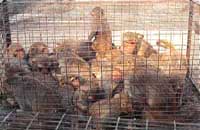monkey business
 they are known to be destructive. They are known to damage crops and property. For this, they are harassed, trapped, hunted and even subjected to government-sponsored extermination campaigns. They are the commensal primates, species which live off humans without meaning to cause them harm (in the context of primates).
they are known to be destructive. They are known to damage crops and property. For this, they are harassed, trapped, hunted and even subjected to government-sponsored extermination campaigns. They are the commensal primates, species which live off humans without meaning to cause them harm (in the context of primates).
In India, three primate species in particular are strongly commensals, namely the bonnet macaque ( Macaca radiata ), the Hanuman langur ( Presbytis entellus ) and, of course, the rhesus ( M mulatta ). But, despite the damage they are capable of causing, monkeys have benefited from India's tradition of veneration for them. Nevertheless, in India, as elsewhere, the damage caused by them can put human endurance to the severest test. This will be particularly true in the years to come given that the country's human population will double in a mere 35 years. Perhaps the species that will be most affected by increasing public disaffection will be the rhesus since most of them live in sites located near or even within human settlement.
Concerned by the trends, primatologists have recently attempted to develop measures to check the growing threat to commensal primates. Of those tried thus far, translocation holds the greatest promise for India's commensal rhesus . Environmentalists, however, have expressed their doubts regarding translocation, fearing that such animals may disturb the ecology of their new habitat. Such risks are real, but there is another, more grave threat. In the absence of any other rational translocation programme, angry communities are likely to impose their own control measures, which could be disastrous. All this calls for a comprehensive management plan for the commensal rhesus.
An ideal situation would be to trap the monkey groups residing in hospitals, schools, government offices and also the Rashtrapati Bhavan in Delhi, sterilise 80 per cent of the females who are between 4 to 10 years of age, then rehabilitate the group at the release site, preferably a monkey sanctuary. It is time the government set up such sanctuaries, which could be located near places of pilgrimage, where there is ample forest cover, water and natural food. As people love feeding monkeys, they would even buy tickets to these sanctuaries. The revenue earned could make the sanctuaries self-sustaining.
But until such a decision is taken, the trapped animals can be relocated near Rishikesh in Uttar Pradesh. Urban monkeys should not be released in forest patches unless quarantined as any disease they could be carrying might spread to other monkeys and wildlife forms.
Here it is necessary to emphasise that among monkeys, translocated individuals usually disperse after release, but not the groups. Relocating animals from a single parent group allows each of the affected monkeys to cope better in the new surrounding.
For instance, monkeys taken from Tughlakabad by Municipal Corporation of Delhi ( mcd ) trappers were reportedly being released singly or in groups of two or five, when and where it was convenient for the trappers. No attempt was being made to determine whether the animals released together actually originated from the same social group. Under these circumstances, any animals relocated by the mcd would probably fare badly in their new surroundings, move to the nearest human habitation or may even return to the place from where they were captured.
The cost of translocation There are probably more than 500,000 rhesus in India today, of which 10 per cent are worthy candidates for relocation. However, even at Rs 300 per monkey, the cost of relocating the primates
Related Content
- Major blow to Kenya’s tourism as fifteen baboons killed every day on Northern corridor
- Body Shop announces £2m 'bio-bridges' scheme to protect endangered rainforest wildlife
- A major concern’: plantation-driven deforestation ramps up in Borneo
- Marauding monkeys to now face bullets in Shimla
- Extinction of monkeys, birds could lead to more severe climate change
- 25 primates on endangered species list
